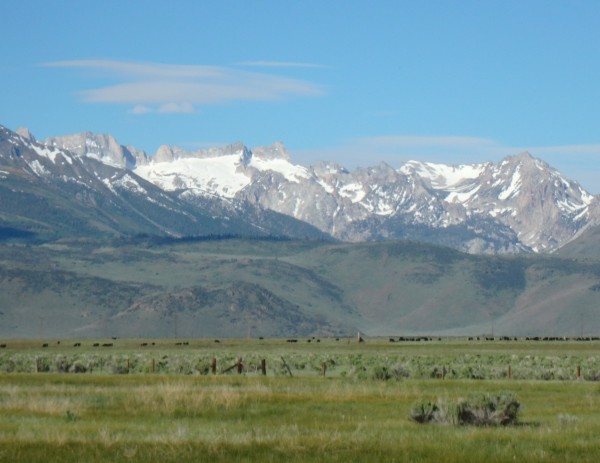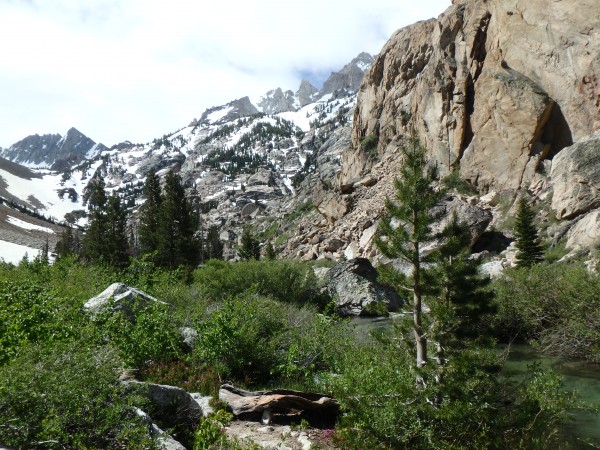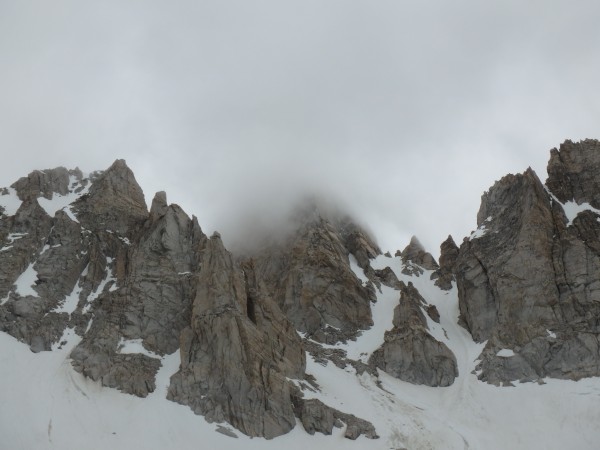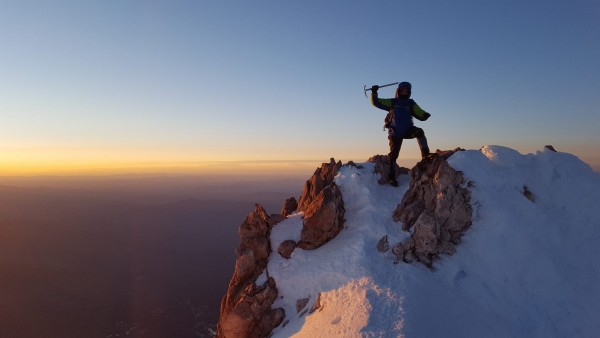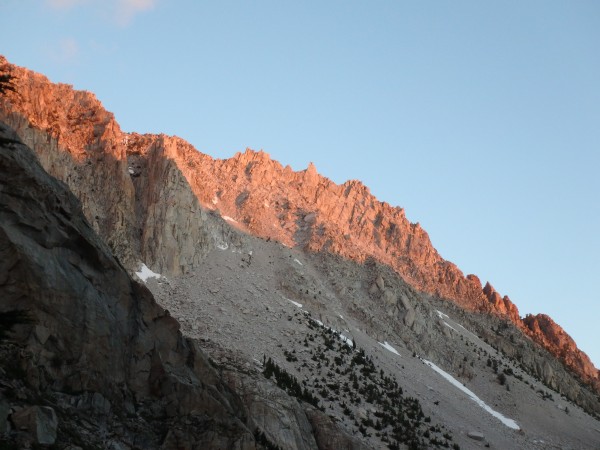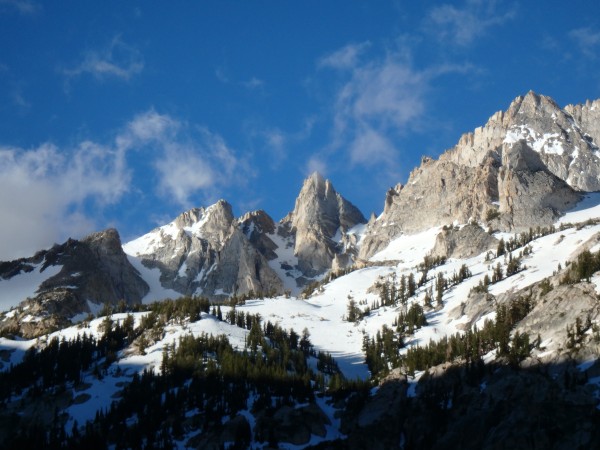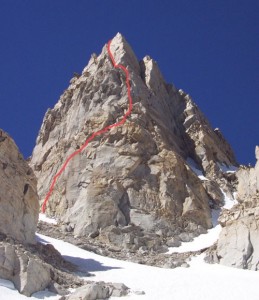Trip Report
Near Demise (?) Attempting Matterhorn Peak
|
Sunday July 10, 2016 7:40pm
|
|
This is one trip report I really wish I did not have to write, but on the flip side, I am quite glad I am here to write it. I decided to share this experience here for a few reasons. First, I am hoping for feedback and thoughts on what may have happened to me and if any one knows or heard of something similar happening to someone else. Second, I hope it can be educational to others venturing out on their own who may be putting themselves in a similar situation. Finally, and probably most important, I think it is an exciting story of a close call worth sharing, though I still have not shared it with my whole family or most of friends.
The story really gets going as I pulled my car into the backpacker parking area around 8:45 AM at the Mono Village Resort, just outside of Bridgeport. Though I believe the mechanisms for my failure and near demise were already set in motion. I had planned to hike up to the 12,264 foot Matterhorn Peak in the Sawtooth Ridge. A few friends had recently climbed up the couloir on the left and took the 4th class ridge to the summit. I would have preferred to climb the 5.7 North Arete, but I was unable to rally a partner and even if I had, the weather was predicted to be in the low 30s with 35MPH winds. Thus, I decided to take the route that my friends had done with plans of checking out the North Arete for another trip later this year.
I had planned to do this trip over two days, so I needed to make camp somewhere. I wanted to make camp high so I could tag the summit, or at least get high enough to where the winds turned me around, and get down early the next day. Just after 12 PM I made camp at approximately 11,000ft. It was a little high, but having spent two days on Mt. Shasta just 72 hours earlier, and made the summit with no issues. I figured the altitude would not be an issue. I made my camp under a large boulder in a boulder field. There was a bit of space underneath one particular boulder as it was propped up on one side by a smaller boulder. I used my shovel to level out the snow under it so I had a flat space, out of the wind, for my bivy sack.
After rolling out my bivy sack, I spent the next two and a half hours keeping warm in it. I took a 30-minute nap and read a few pages in a book I had brought. The wind was quite strong and the clouds that were condensing on and around Matterhorn Peak were getting thicker and coming down lower. I decided to get out of my bivy to eat some soup and go for a short walk around. I wanted to look at some of the rock up close. Some of it looked like really fun and interesting climbing and I had fun trying to find lines that I might want to come back and climb later.
At about 4PM I started the short walk back to my camp. It was at this point that I first noticed that I was feeling a little off my norm. I first noticed that I was stumbling a little as I walked and it took considerable effort to walk normal. I also noticed I was feeling a little light headed and most odd was that my small and ring fingers started to feel numb. Once I got to my camp I knelt down beside it and tried to assess my situation. The numbness in my hands was getting more pronounced and I was beginning to feel very fatigued. I did not recognize my symptoms as being related to the altitude. I did not have any hint of nausea or a headache. The clumsiness and fatigue seamed like they could be related to the altitude, but the numbness in my hands, which was most alarming, seemed out of place. It only took a moment for me to realize resting in place was not the option I should choose and that descending was mandatory. As I gathered my things I focused on taking full, deep breaths in my nose and out my mouth through pursed lips, though I did not feel short of breath at all. The numbness in my hands was becoming more and more pronounced and it was spreading to my arms, shoulders, neck and into my lips and face as well as starting in my feet and legs. I was struggling to get my bivy sack, with sleeping bag still in it, shoved into my pack as I started losing function of my hands and arm. I was beginning to take a conscious effort to close and open my hands. My arms started a very subtle and uncontrollable tremer. I still had a few items to get in my bag, but the rate at which I was loosing control of my body was so alarming that I considered leaving my bag and all my things just to start my descent. I decided I had to take the bag even though I was unable to get all my things inside. I draped the few items I had left to pack over the top of the bag and hoped they would not fall off. I was able to get the bag over my shoulders as I staggered over to the steeper part of the snowfield.
At this point I was having a difficult time holding on to my ice ax and I doubted my ability to self arrest if I found myself sliding really fast down the snow, but I had no option other than to start glissading down, with crampons on. As I lay back with my feet out in front of me sliding down the snow I continued to focus on my breathing and tried to relax every muscle I could to conserve energy and oxygen. The thought that this could some how be hypoglycemia, a condition I have never had, crossed my mind. Fortunately I had a pack of peanut butter crackers in my pocket and was able to open the pack and eat them as I glissaded down. By the time I reached the bottom of this snowy slope, about four of five hundred feet high, the feeling in my lips was coming back. I also felt as though I had a little more energy.
I was able to get on my feet and walk, rather wobbly, around a ridge and though a few trees to the top of another snow slope. On my way up I had seen only one other person and I had seen him here, at the top of this snow slope. He was getting his skies on at the time I saw him and had his dog with him. As I began to glissade down this slope I saw his ski tracks and his dogís paw prints in the snow and knew he was long gone. Once reaching the bottom of this slope, about 1,000 feet in height, I staggered over to a large boulder and hid from the wind. I was feeling much better, but still a long way from normal. My hands and most of my arms were still very numb and difficult to use. While lying down behind the boulder I decided to eat a few packs of gummy fruit snackes that I had in my bag and drink some water. The numbness was slowly going, and my energy was coming back slowly, but I felt I still needed to get down further. The next and last snow slope was about three or so hundred yards away, across a talus field. As I was staggering across the last few hundred feet to the slope I felt the numbness in my hands and feet returning and fast.
Once reaching the bottom of this last snow slope, at about 6 PM, there was only brush and boulders with some short, well defined, trails ahead to navigate. I decided to walk a few feet off the snow to get myself behind a few trees that would shield me from the strong winds as I took off my crampons. I also decided to take the time to get a second pair of pants on to keep me warmer. As I am doing all this, the numbness is coming back up my arms and into my face and I am feeling weaker and weaker by the second. Just as I finished getting my boots back on the weakness was so great I was unable to stand. I decided the only thing I could do was to rollover onto my back and get my feet propped up on my pack. I laid there watching the clouds swirling and changing shape overhead as my body felt as though it was slipping away from me as it became numb and felt like it was vibrating. The muscles in my arms began to feel very tight and looking down at my hands, I saw my fingers curling in to a clenched position as most of my body began to tremble. I still had full control of my breathing and continued to focus on deep-pursed lip breathing. I was also still able to shout. I gave out one shout for help, but found it very scary and unsettling to hear my own voice in distress so I chose to save my energy. I also knew there was little to no chance that there was anyone there.
As my body continued to slowly slip away from me, I started to think that this really could be it. I would have never thought I would die lying on my back in the middle of a trail from some sort of metabolic mechanism that I didnít understand. If I am going to die young, I would have guessed it would have been from a rock fall that snuffs me out while climbing, a shark taking a bite out of me while surfing, maybe sliding my motorcycle into an embankment while racing around in the hills or drowning after getting stuck in a sieve or strainer while white water kayaking. Laying there staring at the clouds unable to feel my body I thought about my parents, friends, coworkers and this girl I just met from some online dating site, ha. I felt bad for their loss, but not for myself. I was bummed that I would not get to go on more adventures, but I was stoked for all that I had already done.
After about 15 to 20 minutes of nearly complete numbness and waiting to have the lights fade out on me, things started to take a turn for the better. I was getting some strength back, but still had very little feeling. I decided I should reach down to my pack and get my foam mat out and roll myself over onto it. This way if I was to pass out I would have a little bit better chance of staying warm and hopefully waking back up. A few minutes later I had enough energy to reach back down to my pack for food. As I clawed at my bag for food a can of condensed soup came out. I was not able to pull the top off with my hand, but I was able to pick up my ice ax and use the spike to pry the can open. I also used the end of the ice ax to shovel some of the soup into my mouth, as I could not reach the spoon, but did not have the energy to take more than a few mouthfuls. The next thing I thought I should do was to get my sleeping bag out and slide myself inside.
Once I was in the sleeping bag I started to figure out what might be happening to me. I came up with a good list of possibilities, but the hypothesis that seemed to be most likely was that I had become hypoxic. At first it seemed unlikely. I had been to fourteen thousand feet a number of times and even as high at nineteen thousand feel once and never had an issue with altitude sickness or symptoms like what I was experiencing. In thinking about this a little more I remembered that I had read once that one of the human bodyís reactions to elevation is for the kidneys to start peeing out bicarbonate. Now I did not know how that helps the body acclimate to altitude, but I did know that bicarbonate is the bloods pH buffer and without it the bloods pH must be more labile and susceptible to change. Seeing how I had spent a few days on Mt Shasta, at an altitude of ten thousand feet and higher, only 72 hours earlier, my kidneys had already dumped some of my bicarbonate and it is unlikely that 72 hours is enough time to replenish what I lost. In addition, my muscles were really sore and full of lactic acid after Mt Shasta. Not only had I just climbed Mt Shasta, but I spent three days climbing in Yosemite Valley right before Shasta so every muscle group was feeling a little to very sore when I started up Matterhorn Peak. I hypothesized that the hike up to the base of Matterhorn Peak worked a lot of that lactic acid out of my muscles and into my blood which was unable to maintain its pH, due to the low level of bicarbonate, thus making my blood acidic and compromising my hemoglobinís ability to hold and transport oxygen. This is why I was having such a severe reaction to an elevation that has never been an issue in the past. If this is what really happened to me the best preventive measure I see to take is simply to be better rested before heading up in altitude. I need to allow my body more time to clear out the lactic acid and build up my bicarbonate buffer between high altitude trips.
It was around 8:30 or 9:00 PM, as I lay in my sleeping bag staying warm that I realized I finally felt normal again. I had full feeling back, all the way to my fingertips. I did not know if I was fully recovered or if the symptoms would return with any level of exertion so I chose to spend the night there. I wondered what some one would think if they found me - a person in a bivy sack with his feet on top of his backpack laying head down hill on the trail. Cloths, crampons, food spread out all over the place with a half empty can of condensed Campbellís soup, that had an ice ax in it on the ground. I worried about a ranger finding me and writing a bunch of citations, or worse, a bear coming for my soup and other food items. But I decided I was just going to rest that night not bothering to clean things up.
The next morning after watching the sun come out and the stars and moon fade away from the sky I decided to try standing up for the first time in 12 hours. I took things very slow and cautiously as I gathered my belongings and packed them in my bag. After eating a light breakfast I started my hike down to the car pausing every so often to assess how my body was feeling. I made it back to the car without any issues and have felt just fine ever since.
I have yet to go to any significant elevation since this trip and will probably wait until I have a buddy to go with for the first few trips. However, I will at some point be doing higher altitude trips by myself I am sure. I will just make sure I am better rested and better prepared for a fast descent if one is needed. As I wrote above, I share this story largely for your feedback, so let me have it. Constructive and insightful feedback is preferred, but I have thick skin so feel free to call me out for having been up there alone if you think I am an idiot for that. At least one of my friends already nailed me pretty good for that.
 Kreutzer
Kreutzer
|
 |
About the Author
Kreutzer is from Palo Alto and likes all types of climbing, free, aid, ice, alpine, bouldering, sport, trad.... |
Comments
 donini
donini
Trad climber
Ouray, Colorado
|
 |
|
|
Jul 10, 2016 - 08:12pm PT
|
Whoa....quite a story, thanks for posting. I really can't provide any insight. I have been in many stressful situations at altitude where I suffered physically but I never have experienced the symptoms you described. Looking forward to feedback from others.
|
|
 crankster
crankster
Trad climber
No. Tahoe
|
 |
|
|
Jul 10, 2016 - 08:17pm PT
|
Weird. Hard to imagine it wasn't altitude related. I'd see your dr. for a checkup.
|
|
 Sierra Ledge Rat
Sierra Ledge Rat
Mountain climber
Old and Broken Down in Appalachia
|
 |
|
|
Jul 11, 2016 - 02:28am PT
|
Hmmmm.... Sounds like hyperventilation syndrome
EDIT: It can turn into a runaway train
|
|
 looks easy from here
looks easy from here
climber
Santa Cruzish
|
 |
|
|
Jul 10, 2016 - 08:37pm PT
|
hyperventilation My immediate reaction also. Numbness in face and hands, cramping and spasming of hands and feet (carpel pedal spasms), loss of coordination, dizziness, all pretty traditional signs and symptoms. And ironically the deep breathing you were doing to try to fix it would make it worse. It sounds silly but it can get pretty extreme-during my medic internship I saw a kid brought into the hospital who looked almost like he was having a seizure his spasms were so bad.
That being said, it's pretty easy to play arm chair doctor. Might be worth getting a stress test done before exerting yourself like that again.
|
|
 neebee
neebee
Social climber
calif/texas
|
 |
|
|
Jul 10, 2016 - 08:42pm PT
|
hey there, say... oh my, sure hope you learn what this was...
:O
|
|
 Mark Rodell
Mark Rodell
Trad climber
Bangkok
|
 |
|
|
Jul 10, 2016 - 08:44pm PT
|
I have no idea what may have caused your issues. Yes, attitude seems possible but I want to say you did well. Your actions may have saved your ass. Good job.
|
|
 Ghost
Ghost
climber
A long way from where I started
|
 |
|
|
Jul 10, 2016 - 09:08pm PT
|
Go see a doctor. That's some crazy shizz.
What Tami said.
Sure doesn't sound like anything altitude-related I've heard of. Maybe SLR is right about the hyperventilation thing, but...
|
|
 Sierra Ledge Rat
Sierra Ledge Rat
Mountain climber
Old and Broken Down in Appalachia
|
 |
|
|
Jul 10, 2016 - 10:04pm PT
|
Great pics, BTW, love that place
|
|
 ms55401
ms55401
Trad climber
minneapolis, mn
|
 |
|
|
Jul 10, 2016 - 10:12pm PT
|
I did know that bicarbonate is the bloods pH buffer and without it the bloods pH must be more labile and susceptible to change. Seeing how I had spent a few days on Mt Shasta, at an altitude of ten thousand feet and higher, only 72 hours earlier, my kidneys had already dumped some of my bicarbonate and it is unlikely that 72 hours is enough time to replenish what I lost.
I don't understand any of this.
|
|
 Stewart Johnson
Stewart Johnson
Gym climber
top lake
|
 |
|
|
Jul 10, 2016 - 10:24pm PT
|
You didn't mention how much water you were drinking
Chronic dehydration and acute mountain sickness would make sense
3-4 liters a day? Minimum.
Ever read books on the subject?
Plenty of info out there .
|
|
 Batrock
Batrock
Trad climber
Burbank
|
 |
|
|
Jul 10, 2016 - 11:42pm PT
|
Sounds like hyperventilation syndrome to me also. I've seen quite a bit of it over the years.
|
|
 Gnome Ofthe Diabase
Gnome Ofthe Diabase
climber
Out Of Bed
|
 |
|
|
Jul 11, 2016 - 07:04am PT
|
About the Author
Kreutzer is from Palo Alto . . .
"As I wrote above, I share this story largely for your feedback, so let me have it. Constructive and insightful feedback is preferred, but I have thick skin so feel free to call me out for having been up there alone if you think I am an idiot for that. At least one of my friends already nailed me pretty good for that".
Some one with your -full all in- style, might know to take rest as seriously as action. You need to let the body decompress, de-stress and then recover, think three days,
Unless your old then the luxury of rest is a trade off ~ "now or when I'm dead", "to the summit" he said , and then died on the spot.
Or as the Donini shows,
never quit, climbing, the fount' of youth
Till it puts you on ice.
|
|
 donini
donini
Trad climber
Ouray, Colorado
|
 |
|
|
Jul 11, 2016 - 07:07am PT
|
I'm not sure lack of rest was the most important factor. I've always wondered about climbers from Cali constantly going from sea level to altitude with no acclimatization. It's bound to create problems for some people..
|
|
 O.D.
O.D.
Trad climber
LA LA Land
|
 |
|
|
Jul 11, 2016 - 07:27am PT
|
The symptoms sure seem like those associated with hyperventilation. I've experienced that a couple of times, and genuinely felt I was at death's door. In each case, I had become rapidly dehydrated due to a bout with severe influenza. Maybe dehydration played a role in your case, following your exertions before you headed to Matterhorn Peak?
|
|
 rwedgee
rwedgee
Ice climber
CA
|
 |
|
|
Jul 11, 2016 - 08:18am PT
|
Wow, that is scary. Glad you are all right. Funny how thoughts of getting tooled for littering come to mind while you are possibly dying. So if it were hyperventilation would the "breathing in a bag" thing have helped ?
I hope you get an answer to what caused this as it would be difficult to venture out again alone or otherwise knowing you might be sitting on a time bomb. Keep us posted.
|
|
 Doug Robinson
Doug Robinson
Trad climber
Santa Cruz
|
 |
|
|
Jul 11, 2016 - 08:49am PT
|
Reascent altitude sickness is a strong possibility. I have seen it a number of times, though never such a dramatic case, and it does sound like you aggravated it by hyperventilating.
A study done on residents of Leadville, Colorado established reascent altitude sickness as three times more likely than simply altitude sickness alone. They studied residents of Leadville, at 11,000 feet, who went down to Denver, at 5,000 feet -- the "mile high city," right? -- and then back up to Leadville, only to show up with altitude sickness at the elevation where they lived.
Having summited Shasta 72 hours before was not an advantage but a risk factor. Sounds like for you it turned out to be a huge one. You made the perfect choice to start down while you still could.
In my experience altitude sickness in general is far more common, and far more threatening, than most people give it credit for. The Mount Whitney Trail provides case after case, every summer day, of people who barely sleep a few hours at the trailhead, go up fast (being in good shape has nothing to do with immunity to altitude, and ascending quickly is of course a huge risk factor, often ignored), get hit hard by the altitude, and, fortunately, stagger downhill, which happens to save them.
Your bicarbonate theory is certainly involved, but we would need ex[pert researchers to weigh in on the exact progression here. Get some Diamox and use it prophylactically. It's quite safe and effective.
|
|
 micronut
micronut
Trad climber
Fresno/Clovis, ca
|
 |
|
|
Jul 11, 2016 - 09:16am PT
|
Glad you made it out of there and I really appreciate the report. Hopefully we all learn something here.
First off, before we all start hypothulatin' here, you need to go see a physician and get a basic blood panel done. You really need a baseline before going on a wild goose chase. But lets assume all your values come back within normal range. No B12 deficiency, no hypokalemia, no red or white blood cell issues, etc.....then we can start guessing.
If that's the case then I would lean toward an electrolyte issue. Dehydration, altitude, electrolytes. That would be my guess. The lobster claws, numbness and stumbling all fit right in line with bonking on an electrolyte level. When you ask hard core survivalists about real nightmare scenarios, especially swamp/tropics near death situations, they'll tell you their salt packets they carry saved their lives. No amount of drinking water can bring you back from the brink once you pass "the point of no return" when it comes to electrolytres and sodium/potassium. This occurs at a cellular level and is debilitating and frightening. Just my guess that somehow you tipped the scales and spiraled downhill rapidly.
Your salty crackers and snacks may have saved the day. Losing altitude helped. This is my hypothesis and working diagnosis:
Altitude induced hyponatremia/hypokalemia with concomitant dehydration and associated ataxia. You bonked. Big time. Hope you find some answers. Take care and keep us in the loop!
See a physician! Don't rely on us internet goofballs. Get some answers and we'll see you in the hills!
Scott
|
|
 Reilly
Reilly
Mountain climber
The Other Monrovia- CA
|
 |
|
|
Jul 11, 2016 - 09:46am PT
|
Hydration/electrolyte was my first reaction, too. Actually my first thought was a TIA,
transient ischemic attack, but given your age it is not very likely. Do see a real doc,
you never know.
As to Doug's reascent syndrome I've always benefited from doing so but that proves
nothing as I've always considered altitude sickness quixotic, if not random. When I
lived in Seattle I guided somebody up Liberty Ridge. We bivied at 11,500'. I wasn't
feeling great, to put it mildly, but I knew I could make it. My victim was really bad so
we bailed in the morning. Three days later I took another couple up a different route
and I never felt better. That was the norm for me.
|
|
 Killer K
Killer K
Boulder climber
Sacramento, CA
|
 |
|
|
Jul 11, 2016 - 10:08am PT
|
It sounds exactly like a panic attack. I had similar symptoms that hit within minutes. Your mind can do funky things with your body. I felt like I was going to die as well.
|
|
 NutAgain!
NutAgain!
Trad climber
https://nutagain.org
|
 |
|
|
Jul 11, 2016 - 10:25am PT
|
Bump for more interest in hearing more about this issue. If there is an implication for hitting high peaks a few days apart with maximal effort relative to physical condition and altitude adjustment, that seems to be very relevant for many of us in California.
I have always been afraid of hiking alone because of the big possible consequences of a little random mistake (e.g. twisted ankle). It's also always in the back of my mind when going on adventures with my kids... I have to leave a margin of safety to not have them face a horrible situation they are not prepared to deal with on their own.
For comparison, I can share an experience with hypoglycemic shock, basically bonking, induced by over-exertion and lack of food. No altitude issues. Symptoms slightly different: tunnel vision (black around the edges) while hiking uphill too fast relative to my physical condition; "lobster hands" as micro called it, where fingers curl up, stop responding. I think it started to affect up to elbows- always fun in the middle of a lead. I had that once on NEB HCR when I was really out of shape but dreaming big and partnered with someone in much much better shape than me. That issue resolved very quickly after I ate some food with sugar in it. I don't recall any sensation of numbness.
Do any folks here go into the sierras with salt+sugar packs to stick in water bottles? Seems like a good idea. Sometimes I use gatorade, but I'm afraid of the brominated something-or-other they add to it.
(edit: looks like that ingredient isn't there any more: http://en.wikipedia.org/wiki/Brominated_vegetable_oil);
|
|
 skcreidc
skcreidc
Social climber
SD, CA
|
 |
|
|
Jul 11, 2016 - 10:34am PT
|
Thanks for posting that up, and glad you made it down. I would reinforce on the "definitely go see your doctor about what happened" idea.
|
|
 FRUMY
FRUMY
Trad climber
Bishop,CA
|
 |
|
|
Jul 11, 2016 - 01:50pm PT
|
TFPU
|
|
 labrat
labrat
Trad climber
Erik O. Auburn, CA
|
 |
|
|
Jul 11, 2016 - 02:25pm PT
|
Thanks for posting. Glad you made it. Go get checked out. Then continue with trying to figure it out.
|
|
 looks easy from here
looks easy from here
climber
Santa Cruzish
|
 |
|
|
Jul 11, 2016 - 02:28pm PT
|
When was this? I imagine that if it's been even a couple days an electrolyte imbalance would be hard to confirm at this point.
|
|
 drljefe
drljefe
climber
El Presidio San Augustin del Tucson
|
 |
|
|
Jul 11, 2016 - 02:35pm PT
|
A friend experienced the same thing doing Holotropic Breathwork.
Hyperventilating throws the alkaline levels in your blood wacky.
Did you feel like you were tripping?
|
|
 Ezra Ellis
Ezra Ellis
Trad climber
North wet, and Da souf
|
 |
|
|
Jul 12, 2016 - 03:33am PT
|
All of the above are reasonable theories , but I doubt you'll ever know for sure.
Glad you are ok, I would probably go with a partner in the future.
A simple virus at altitude can be devastating.
Dehydration, electrolyte issues, hyperventilating, lack of food/ hypoglycemia .
Who knows?
Best,
Ezra
|
|
 EdwardT
EdwardT
Trad climber
Retired
|
 |
|
|
Jul 12, 2016 - 10:21am PT
|
A few years back, I spent a week in the San Juans, bagging 14ers. On the first day (24 hours after leaving sea level), we bagged two 14ers. No problems, except for a headache. The rest of the week went fine (including camping over 11,000), except for the last day. Coming down from our 7th peak, I developed a nasty, unrelenting cough. Got down below 9000'. Took some nyquil. Went to bed. Felt fine the next morning.
They say altitude sickness is a craps shoot. Glad you didn't crap out.
Thanks for sharing your story.
|
|
 JEleazarian
JEleazarian
Trad climber
Fresno CA
|
 |
|
|
Jul 12, 2016 - 11:12am PT
|
I'm sorry you had to suffer, but I'm glad you chose to share your story. I have nothing to add to your narrative, but on the subject of altitude sickness generally, I've found it has no altitude limit, per se. I've suffered altitude sickness just heading over Parker Pass (at 11,000 feet), but not 3,00 feet higher climbing any of the crest peaks in the Sierra. I definitely had it on Mr. Goddard when I was 20, but not on Mt. Dana when I was 60.
Go figure.
|
|
 Nick Danger
Nick Danger
Ice climber
Arvada, CO
|
 |
|
|
Jul 12, 2016 - 12:12pm PT
|
I think Micronut has provided a most thoughtful reply. Seeing your physician and getting some baseline blood work is an excellent way to start sorting this out and avoiding it in the future. Secondly, I agree with him that an electrolyte imbalance sounds plausible. Both hypokalemia and hyponatremia can present as several of the symptoms you describe (muscle cramps, loss of feeling and muscle control) since these types of chemical imbalances affect both nerve signal transmission as well as muscle tissue performance. Also, the intake of food and the timing of symptoms seems to fit an electrolyte imbalance scenario. In my experience hyperventilation comes on quicker but also clears up quicker than you describe, but I might be mistaken on that one. Finally, you might have suffered from a combination of maladies that include, but might not be limited to, electrolyte imbalance, incipient reaclimatization issues, low levels of hypothermia due to the cold wind you were exposed to, and dehydration (although dehydration and hypokalemia/hyponatremia typically are contraindicated). Anyway, glad you made it out safely, and thanks for sharing your experiences for the rest of us to learn from. I hope all your future mountain travels go well and have happy endings.
|
|
 HighTraverse
HighTraverse
Trad climber
Bay Area
|
 |
|
|
Jul 12, 2016 - 07:12pm PT
|
The only thing I have to add is to consider your activity cycle.
You climbed Shasta, 14000+ feet then I assume you went home to sea level.
You don't say specifically but 3 days later I assume you drove from Palo Alto, which is at least 8 hours to Mono Village. You arrive before 9AM. Did you sleep/eat any significant amount on the way?
Next you hiked with a moderate load from 7000 feet to 11000 feet in 3 hours.
That consumed a helluva lot of calories and H2O in a relatively short time. You mention you took shelter in your divvy (your body consuming calories to keep warm) and then a walkabout for something more than an hour in chilly weather.
So roughly speaking:
You climbed Shasta burning a lot of calories and H20. Then drove (or rode in car) 8-10 hours back to Bay Area and sea level.
What did you do to rehydrate and eat to recover?
Then 72 hours later you drive 8 hours and over a 9600 foot pass to arrive at 7000 feet, climb 4000 feet in 3 hours, take a brief rest, go out for a walk and shortly feel ill.
Dehydration?
Insufficient calorie intake between Shasta and Matterhorn?
Both?
Altitude sickness from going from 14000+ to sea level to 11000+ within less than 4 days?
Others have proposed specific illnesses. It's now quite late for lab tests to show anything metabolic that's not related to some underlying pathology. So get the lab tests and IF they still show anything amiss you might consider a thorough medical appraisal.
And then Carry On!
|
|
 Rustie
Rustie
climber
Coeur d\\\\\\\'Alene
|
 |
|
|
Jul 13, 2016 - 09:35am PT
|
Useful philosophical insights. Well done!
Yes -- it is humbling to realize that we are more likely to die from simple medical causes than from dramatic and heroic falls and adventures. Especially at any kind of altitude. Such knowledge is purchased dearly and you had some good returns here. If you choose to take the safer road, you may live longer but such epiphanies will pass you by. The choice is yours, unless you allow yourself to be coerced by pressure from "enemies or loving friends".
Those who choose to ride closer to the edge, and go solo climbing, don't have to do so recklessly -- by substituting preparation and judgement for rope or companion, you can be reasonably safe -- if that's what you want.
All the medical advice seems sound.
But remember that every body is very different, and altitude and exhaustion mask and confuse typical medical symptoms. It is useful to do some tests that will teach you more about your unique body, and how it may respond to physical and psychological stress, but the key thing is to relate these scientific facts to your own biology and psychology.
But......you did the right thing......Ran Like Hell, and so you can persevere, to try again?
Good Luck.
|
|
 LuckyPink
LuckyPink
climber
the last bivy
|
 |
|
|
Jul 13, 2016 - 04:08pm PT
|
Go to an MD . You may be diabetic and not know it yet. No Kidding. Triage is my job at work, I wouldn't focus on the altitude first, its the exertion, symptoms of BONK. Diabetics are fit thin people. Great you knew what to do.. don't spend time thinking about it... Fluids, Food, Warmth, Rest , head downhill.
Good info upthread from Doug re altitude illness ..and the right assessment from High T (heh like my pun? It fits, my friend!)
|
|
|
 |
 |
The route as seen from the approach. Photo: Brad Goya
Recent Trip Reports
- The Kohala Ditch Trail: 36ish hrs on foot... to and from the headwaters. [5 of 5]
May 31, 2019; 11:57pm
- A Winter Traverse of the California section of the PCT Part 8
May 31, 2019; 11:18pm
- Supertopo,A trip report for posterity
May 31, 2019; 11:00pm
- Balch Fest 2013. Two Days in and Around and On The Flake. The Official Trip Report
May 31, 2019; 10:57pm
- TR: My visit to the Canoe
May 31, 2019; 10:24pm
- Death, Alpine Climbing, The Shield on El Cap
May 31, 2019; 4:07pm
- Andy Nisbet (1953-2019)
May 31, 2019; 2:11pm
- Drama on Baboquivari Peak
May 31, 2019; 1:19pm
- Joffre + The Aemmer Couloir: ski descents come unexpected catharsis [part 2]
May 31, 2019; 7:45am
- Lost To The Sea, by Disaster Master
May 30, 2019; 5:36am
- My Up And Down Life, Disaster Master
May 29, 2019; 11:44pm
- Halibut Hats and Climbers-What Gives?
May 29, 2019; 7:24pm
- G Rubberfat Overhang-First Ascent 1961
May 29, 2019; 12:28pm
- Coonyard Pinnacle 50 Years Later
May 29, 2019; 12:24pm
- Great Pumpkin with Mr Kamps and McClinsky- 1971
May 29, 2019; 12:02pm
- View more trip reports >
|
